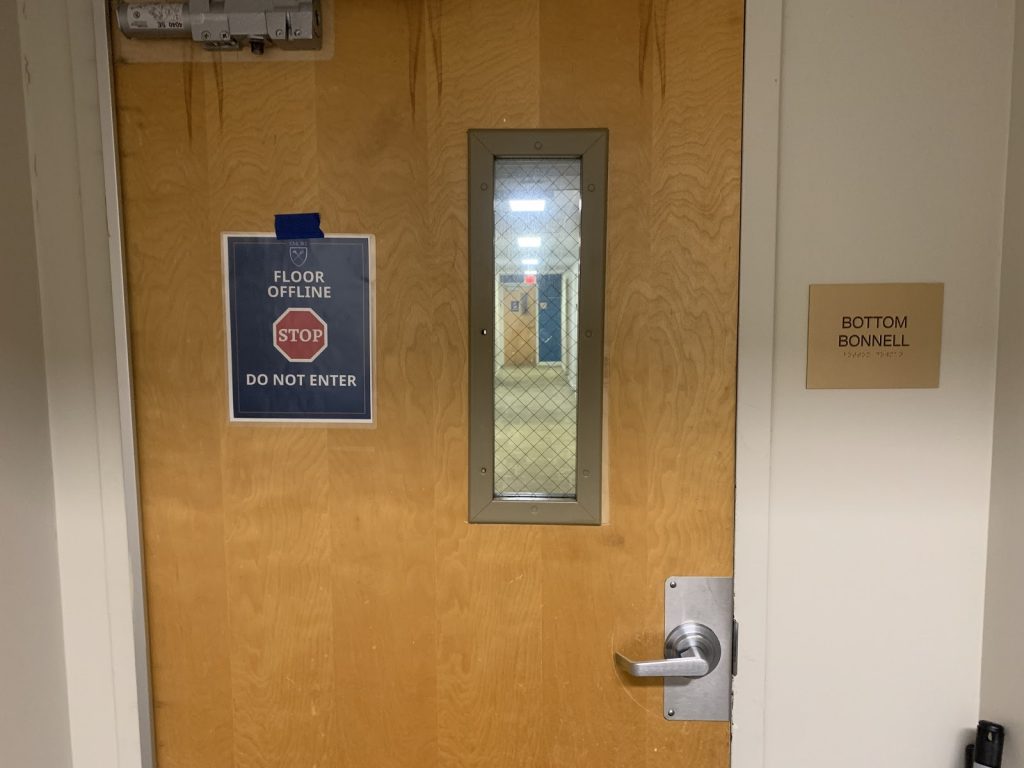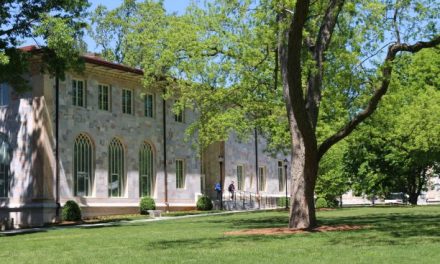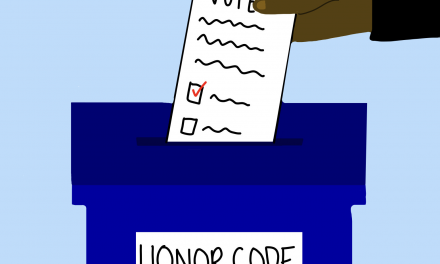Emory’s Oxford campus isolation and quarantine system is facing a new stress test, with the 17 COVID-19 positive cases recorded since Dec. 30, 2020, already outpacing the six total recorded last fall.
Oxford students described a porous isolation system that allows positive students to leave their isolation areas and outside students to come in. Those in quarantine struggled with an abrupt transition and lack of information.
“They immediately moved us in and were like, ‘Here’s the key. Bye, good luck,’” said Rachel Tupler (22Ox), who isolated in Jolley Residential Center’s (JRC) Bonnell residence hall.
Unlike the Atlanta campus, where both COVID-19 positive on-campus students and close contacts are housed at the Emory Conference Center Hotel, Oxford students isolate in campus residence halls — the bottom floors of JRC’s Bonnell and Stone Halls and the first floor of Haygood Hall — and quarantine at the Hampton Inn Conyers.

The door to Bottom Bonnell floor in Jolley Residential Center where COVID-19 positive residents are housed is labeled as an “offline” floor. (Caelan Bailey)
The rooms in JRC and Haygood Hall were chosen for “how the dorms were laid out,” Senior Associate Dean of Finance, Operations and Technology Danielle Miller said. Floor setups in these buildings include doors that corrall the halls and a shared bathroom, as opposed to the open floor plan of newer dorms.
When students first test positive, an isolation and quarantine team transports them to the isolation dorms where they receive a care package and meet virtually with Student Health Services (SHS) staff daily, said Miller. Close contacts undergo the same process.
Proximity to other students
In JRC and Haygood Hall, three designated “offline” floors have signs around entrances that warn students not to enter but do not explicitly indicate that the floors are used for isolation. Doors to all floors are unlocked and accessible via communal stairwells, and the floors are attached to outside exits.
Students live in floors above and in halls near the closed isolation floors. Arushi Dhillon (22Ox), who lives in JRC’s Dickey residence hall near Bonnell Hall, said she had “no idea” she would be living near the isolation floor before arriving on campus, and Oxford did not notify residents that “offline” floors are for isolation.
Dhillon said she “might’ve accidentally opened the door” to the Bonnell isolation floor in the past and that a fire alarm last semester required all JRC residents to exit the building at once.
“Why would they send the people that don’t have COVID, that were exposed to someone with COVID, to the hotel and not the actual person with COVID?” Dhillon asked.

A door from the bottom floor of Jolley Residential Hall (JRC) leads out to the Oxford Dining Hall. (Caelan Bailey)
Miller said that while both campuses share similar public health goals, safety protocols vary because of resources and population size. Assistant Vice President of Communications and Public Affairs Laura Diamond wrote in an March 8 email to the Wheel that isolated students’ proximity to SHS and the dining hall allows staff to “provide maximum healthcare and wraparound services.”
Mixed emotional support
Riya Khanna (22Ox) recently left isolation in Stone Hall. While Khanna’s symptoms have largely abated, she said post-isolation communication from SHS has been “poor.”
“I definitely don’t feel 100% back to normal — there’s definitely an impact that COVID had on my body — but they haven’t checked on me at all,” Khanna said, who provided her temperature and blood oxygen level in daily telehealth meetings. SHS also provided a phone number that Khanna could text.
SHS allowed Khanna’s isolation group to request escorted outdoor walks through a nearby Oxford neighborhood “as many times as [they] want[ed],” also allowing them to eat lunch in the JRC courtyard.
Following a Super Bowl watch party, Tupler tested positive for COVID-19 and went into isolation in Bonnell. She recounted feeling shocked as she processed the news.
“They never really stop to ask you, ‘How are you doing?’” Tupler said. “I definitely cried because it was kind of scary.”
Tupler described her time in isolation as “kind of a nightmare,” noting, “It was lonely … I actually had to reach out to the counseling services just because I wanted to talk to somebody.”
She expressed frustration at the fact that close contacts, who tested negative and were asymptomatic, were transported to the Hampton Inn.
Lack of security
Isolation areas are not monitored by staff, and isolated students recounted instances outside of chaperoned time when they did or could have left their halls.
Tupler noted that, on one instance, she locked herself out of her room and had to leave the building to notify a staff member to let her back in.
William Dougherty (22Ox) isolated in JRC’s Bonnell last semester. Aside from the door exit, Dougherty noted that Bonnell’s windows opened to ground level.
“It was a lot based on your own values if you were going to actually go out,” Dougherty said. Tupler said he had heard of individuals who left their halls while in isolation.
However, Miller assured that the building and the integrity of the protocol was secured, saying, “We haven’t had any incidents or any cases where students left without our knowledge. We trust that [students] will listen to the recommendations.”
Miller described off-campus houses reserved for isolation as the “first go-to” for a backup plan if residential isolation dorms on campus were overcrowded due to a surge in cases.
Derek Newton (22Ox) briefly isolated in a house near campus after experiencing COVID-19 symptoms. After self-reporting symptoms to the screening questionnaire, he was prompted to call SHS. The process was “a little bit more complicated” than he anticipated, given he had to navigate to Oxford-specific information and call multiple times before receiving a response.
SHS then organized a telehealth meeting as well as two rounds of rapid and PCR tests. Once those tests returned negative, Newton was allowed to return to his dorm.
Close contacts
For close contacts, the quarantine experience at the Hampton Inn is taxing. Kenneth Wingate Jr. (22Ox) said he felt “a little ill-informed” after being given three hours to pack his belongings.
The food was “probably the worst part of quarantine,” Wingate said, as students could not choose from the dining hall, and most ordered takeout from local restaurants. The staff created a Google form to ask for students’ preferences a week in, but Wingate Jr. said that requests often remained unfulfilled.
SHS staff transported residents in quarantine to receive COVID-19 testing twice during their stay. Wingate Jr. tested negative both times.
“We were actually pretty upset because the people in isolation, who actually tested positive, got out earlier than the close contacts who tested negative,” Wingate said.
Despite staff efforts to care for students’ needs, Wingate said that he “will do everything I can to not have to go back” because “it was actually terrible.”
Calvin Bell III (22Ox) described a similar experience when he quarantined after being identified as a close contact despite receiving a negative saliva test result earlier that day. A first-year senator for the Student Government Association, Bell plans to create a podcast for students to voice qualms with isolation.
Though Miller noted that close contacts are tested twice during the 10-day quarantine period, Bell said he was only tested once. Bell wished that there were more resources for students’ mental health while in quarantine, explaining, “It would’ve been nice to get to talk to other students in quarantine and isolation, maybe over Zoom, to foster that community.”
Caelan Bailey (22Ox, 24C) is from Charleston, South Carolina.






